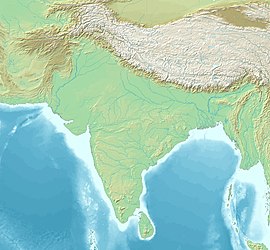வசிஷ்கன்
| வசிஷ்கன் | |
|---|---|
| குசானப் பேரரசன் | |
 | |
| ஆட்சி | 247–265 பொ.ச. |
| முன்னிருந்தவர் | இரண்டாம் கனிஷ்கன் |
| பின்வந்தவர் | மூன்றாம் கனிஷ்கன் |
வசிஷ்கன் (Vāsishka ; [3] ஆட்சி சுமார் 247-265 பொ.ச.) ஒரு குசானப் பேரரசனாவார். இவர் இரண்டாம் கனிஷ்கனுக்குப் பின் குறுகிய கால ஆட்சியைக் கொண்டிருந்தார்.
ஆட்சி[தொகு]
பஞ்சாப் பகுதி, மதுரா (இசாபூர் கல்வெட்டு) ஆகிய பகுதிகளில் வசிஷ்கரின் ஆட்சிக்கால கல்வெட்டுகள், [4] கண்டறியப்பட்டுள்ளன. [5] இவரது ஆட்சி தெற்கே சாஞ்சி வரை இருந்ததாக பதிவு செய்யப்பட்டுள்ளது. அங்கு இவரது பெயரில் ஒன்று அல்லது இரண்டுக்கும் மேற்பட்ட கல்வெட்டுகள் கண்டுபிடிக்கப்பட்டுள்ளது. இது, குசான சகாப்தத்தின் 22 ஆம் ஆண்டு தேதியிடப்பட்டுள்ளது ("வஸ்குஷனா" சாஞ்சி கல்வெட்டு) , ஆண்டு 28 (வசஸ்காவின் சாஞ்சி கல்வெட்டு-அதாவது வசிஷ்கன்) (கனிஷ்கர் சகாப்தத்தின் இரண்டாம் நூற்றாண்டு என்று பரவலாக கருதப்படுகிறது). இது இவரது ஆட்சியை பொ.ச. 247–265 என வரையறுக்கலாம்.
கல்வெட்டுகளும் சிலைகளும்[தொகு]
சிந்து பகுதியில் உள்ள கரோஷ்டி கல்வெட்டு உட்பட நான்கு அறியப்பட்ட கல்வெட்டுகளில் வசிஷ்கனைப் பற்றியத் தகவல்கள் இடம்பெற்றுள்ளன. [6]
சாஞ்சி போதிசத்துவர்[தொகு]
மதுராவின் கலைப் படைப்புகளிலிருந்து வசிஷ்கன் என்ற பெயருடன் பல சிலைகள் அல்லது சிலை துண்டுகள் சாஞ்சி தளத்தில் கண்டுபிடிக்கப்பட்டுள்ளன. [7] அமர்ந்துள்ள போதிசத்துவரின் சிலை ஒன்றின் பீடத்தில், "வசிஷ்கனின் 28-ஆம் ஆட்சியாண்டு" என தேதியிடப்பட்டுள்ளது.[8]
சாஞ்சி பீடம்[தொகு]
சாஞ்சியில் காணப்படும் மற்றொரு கலைப்படைப்பு, நிற்கும் புத்தரின் சிலையின் பீடமாகும். [9] கல்வெட்டில் "வஸ்குசானனின் ஆட்சியாண்டு 22" என பொறிக்கப்பட்டுள்ளது. இது "வசிஷ்க குசானன்" என்று கருதப்படுகிறது. [10] [11] குசான பாணியின் வழக்கமான இடுப்பு பட்டைகளுடன் கூடிய நீண்ட அங்கியில் வழிபடுபவர்கள் அமர்ந்த போதிசத்துவரைச் சுற்றி நிற்பதைக் காணலாம். [12]
ஆரா கல்வெட்டு[தொகு]
அட்டோக்கின் தெற்கே சிந்து பகுதியில் காணப்படும் இரண்டாம் கனிஷ்கனின் "ஆரா கல்வெட்டில்" வசிஷ்கன் தோன்றுகிறார். இந்தக் கல்வெட்டில், இவர் கனிஷ்கரின் தந்தையாகக் காட்டப்படுகிறார். மூன்றாம் கனிஷ்கரனாகவும் கருதப்படுகிறார். மேலும் இவரது பெயர் கரோஷ்டி எழுத்துமுறையில் "வஜேஷ்கா" என்று தோன்றுகிறது. [2]
வசிஷ்கரின் இசாபூர் கல்வெட்டு, ஆண்டு 24[தொகு]
வசிஷ்கனின் பெயரில் தூய சமசுகிருதத்தில் மத்திய கால பிராமி எழுத்துமுறையில் ஒரு கல்வெட்டு, இவரது முழு ஏகாதிபத்திய பட்டங்களுடன் மஹாராஜஸ்ய ராஜாதிராஜஸ்ய தேவபுத்ரஸ்ய ஷாஹே வசிஷ்கஸ்ய ("பெரிய மன்னன், அரசர்களின் அரசன், அவனது மாட்சிமை, ஷாஹி வஷிஷ்கா" என உள்ளது. இது (27°30′41″N 77°41′21″E / 27.5115°N 77.6893°E ), மதுரா நகருக்கு அருகில் கண்டுபிடிக்கப்பட்டது. தற்போது மதுரா அருங்காட்சியகத்திலுள்ள " யூபா " என்ற தியாக பிராமண தூணின் தண்டின் மீது உள்ளது. [13] [14]
நாணயம்[தொகு]

வசிஷ்கனின் நாணயங்கள் இவரது முன்னோடிகளை விட சிறியதாக மாறியது. [15] இவரது நாணயத்தின் பின்புறத்தில் தோன்றும் தெய்வங்கள் குவிஷ்கன் மற்றும் முதலாம் வாசுதேவன் ஆகியோரின் நாணயங்களில் உள்ளதைப் போலவே உள்ளன. [15]
குசான-சாசானிய ஆட்சியாளரான முதலாம் அர்தசிர் குசான்ஷாவின் நாணயங்களுடன் வசிஷ்கனின் பல நாணயங்கள் கண்டுபிடிக்கப்பட்டுள்ளன. இது இரண்டு ஆட்சியாளர்களுக்கு இடையிலான போட்டி மற்றும் தொடர்புகளின் அளவைக் குறிக்கிறது. [16]
வசிஷ்கனின் நாணயங்கள் பொதுவாக கிரேக்க-பாக்திரிய எழுத்துக்களில் "அரசருக்கெல்லாம் அரசன்" என உள்ளன. [17]
சற்றே வித்தியாசமான பெயர் கொண்ட சில நாணயங்கள் "ராஜா பசோடியோ தி குசான ராஜா") பொதுவாக வசிஷ்கனுக்கு சமமான "வஷ்குசானா" என்று கூறப்பட்டுள்ளது. [18] [19]
குறிப்புகள்[தொகு]
- "Ancient Indian Inscriptions", S. R. Goyal, 2005
- "From Persepolis to the Punjab: Exploring Ancient Iran, Afghanistan and Pakistan", Elizabeth Errington and Vesta Sarkhosh Curtis, 2007.
- The Crossroads of Asia: Transformation in Image and Symbol", Elizabeth Errington and Joe Cribb, 1992.
சான்றுகள்[தொகு]
- ↑ CNG Coins notice
- ↑ 2.0 2.1 Rosenfield, John M. (1967) (in en). The Dynastic Arts of the Kushans. University of California Press. பக். 57. https://books.google.com/books?id=udnBkQhzHH4C&pg=PA57.
- ↑ Konow, Sten, Kharoshṭhī Inscriptions with the Exception of Those of Aśoka, Corpus Inscriptionum Indicarum, Vol. II, Part I. Calcutta: Government of India Central Publication Branch, p. 163
- ↑ Rezakhani, Khodadad (2017) (in en). From the Kushans to the Western Turks. பக். 203. https://www.academia.edu/32671225.
- ↑ Rosenfield, John M. (1967) (in en). The Dynastic Arts of the Kushans. பக். 57. https://books.google.com/books?id=udnBkQhzHH4C&pg=PA57.
- ↑ Rezakhani, Khodadad (2017) (in en). From the Kushans to the Western Turks. பக். 203. https://www.academia.edu/32671225.Rezakhani, Khodadad (2017). From the Kushans to the Western Turks. p. 203.
- ↑ Mitra, Debala (2001). Sanchi. Archeological Survey of India. பக். 7 Note 1. https://archive.org/details/sanchi00mitr/page/7.
- ↑ Kuraishi, Mohammad Hamid (1922). Catalogue of the Museum of Archaeology at Sanchi, Bhopal State. Calcutta, Superintendent Government Printing, India. https://archive.org/details/cu31924023945110/page/n35.
- ↑ Mitra, Debala (2001). Sanchi. Archeological Survey of India. பக். 7 Note 1. https://archive.org/details/sanchi00mitr/page/7.Mitra, Debala (2001). Sanchi. Archeological Survey of India. p. 7 Note 1.
- ↑ Dani, A. H. (1994). History of Civilizations of Central Asia: The Development of Sedentary and Nomadic Civilizations, 700 B. C. to A. UNESCO. பக். 253. https://books.google.com/books?id=9U6RlVVjpakC&pg=PA253.
- ↑ "He might have begun to rule even two years earlier if he can be identified with king Vaskushana(=Vasishka Kushana?) of a Sanchi record of the year22" Shashi, Shyam Singh (1999). Encyclopaedia Indica: The Kushana Empire: government, society, and culture. Anmol Publications. பக். 23. https://books.google.com/books?id=lvwvAQAAIAAJ.
- ↑ Kuraishi, Mohammad Hamid (1922). Catalogue of the Museum of Archaeology at Sanchi, Bhopal State. Calcutta, Superintendent Government Printing, India. https://archive.org/details/cu31924023945110/page/n35.Kuraishi, Mohammad Hamid; Kak, Ram Chandra; Chanda, Ramaprasad; Marshall, John Hubert (1922). Catalogue of the Museum of Archaeology at Sanchi, Bhopal State. Calcutta, Superintendent Government Printing, India. pp. 29–32.
- ↑ Catalogue Of The Archaeological Museum At Mathura. 1910. பக். 189. https://archive.org/details/in.ernet.dli.2015.107003/page/n261.
- ↑ Rosenfield, John M. (1967). The Dynastic Arts of the Kushans. University of California Press. பக். 57. https://books.google.com/books?id=udnBkQhzHH4C&pg=PA57.
- ↑ 15.0 15.1 Rezakhani, Khodadad (2017). From the Kushans to the Western Turks. பக். 203. https://www.academia.edu/32671225.Rezakhani, Khodadad (2017). From the Kushans to the Western Turks. p. 203.
- ↑ Rezakhani, Khodadad (2017). ReOrienting the Sasanians: East Iran in Late Antiquity. Edinburgh University Press. பக். 134. https://books.google.com/books?id=VjVYDwAAQBAJ&pg=PT134.
- ↑ Singh, Arvind Kumar (1996) (in en). Coins of the Great Kushanas. Parimal Publications. பக். 23. https://books.google.com/books?id=qFQWAQAAIAAJ.
- ↑ Friedberg, Arthur L.; Friedberg, Ira S.; Friedberg, Robert (2017) (in en). Gold Coins of the World - 9th edition: From Ancient Times to the Present. An Illustrated Standard Catlaog with Valuations. Coin & Currency Institute. பக். 474, coin 38-39. பன்னாட்டுத் தரப்புத்தக எண்:9780871840097. https://books.google.com/books?id=VHZEDgAAQBAJ.
- ↑ "The coins bearing the legend 'ShaonanoShao Ba-Zodeo/Bozoeo Koshano', ('PAONANOPAO BA-ZOAHO / BOZOHO KOPANO') starts at 1 o'clock have 46 been attributed to Vaskushana (Vasishka) by Gobl." in Bhavan, Bharat Kala; Sharma, Savita (1999) (in en). Gold Coins of Imperial Kushāṇas and Their Successors in Bharat Kala Bhavan. Bharat Kala Bhavan, Banaras Hindu University. பக். 51. https://books.google.com/books?id=j1dmAAAAMAAJ.

